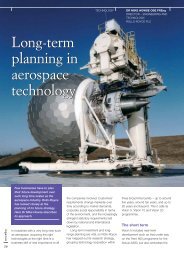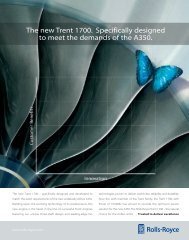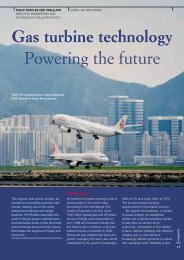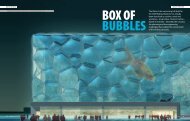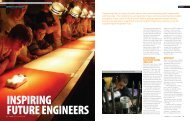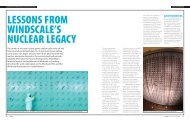Shipping safety - Ingenia
Shipping safety - Ingenia
Shipping safety - Ingenia
You also want an ePaper? Increase the reach of your titles
YUMPU automatically turns print PDFs into web optimized ePapers that Google loves.
DOUGLAS FAULKNER FREng<br />
EMERITUS PROFESSOR OF NAVAL<br />
ARCHITECTURE & OCEAN<br />
ENGINEERING, UNIVERSITY OF<br />
GLASGOW<br />
MARINE MATTERS<br />
<strong>Shipping</strong> <strong>safety</strong><br />
A matter of concern<br />
Some newer ships such as the<br />
Stena Vision here are designed<br />
with <strong>safety</strong> and reduction of<br />
pollution in mind, but with a<br />
steadily ageing world shipping<br />
fleet and declining standards of<br />
maintenance, there is increasing<br />
concern about ship <strong>safety</strong>. The<br />
issues involved are considered<br />
here and some suggestions are<br />
given for implementing improved<br />
shipping <strong>safety</strong>.<br />
Photo courtesy of Jan Zaborowski of Stena Bulk<br />
ingenia<br />
13
MARINE MATTERS<br />
Air travel may be the fastest<br />
growing transport mode<br />
(<strong>Ingenia</strong>, August 2001, Issue 9)<br />
but in terms of cost per tonne mile<br />
shipping at about £0.25 per tonne mile<br />
is an order of magnitude more efficient<br />
than road transport and two orders<br />
more efficient than air freight. Ships<br />
therefore continue to carry around 95%<br />
of international freight, compared with<br />
about 0.5% for air freight. It follows<br />
that shipping remains the most<br />
important transport mode for the<br />
world’s economic and social wellbeing.<br />
Future demands from the developing<br />
countries will place an increasing load<br />
on shipping, which is a slow and<br />
reactive industry. Even today, real<br />
technical and human issues of ship<br />
<strong>safety</strong> exist, which are not being<br />
adequately addressed. This article<br />
briefly reviews the present position and<br />
possible future scenarios for<br />
improvement.<br />
Indicative shipping data and<br />
projected growth<br />
Available statistics on ships (and ship<br />
<strong>safety</strong>) can vary significantly, hence the<br />
first adjective above. Table 1 is derived<br />
mainly from the British Chamber of<br />
<strong>Shipping</strong> data for the world fleet and<br />
from the widely used Fearnleys’ Annual<br />
Review 2001 for sea borne trade.<br />
Values for the year 2000 have been<br />
collectively adjusted into three cargo<br />
and ship types, hopefully to make the<br />
data more understandable.<br />
From Table 1 we see that the dry<br />
and liquid bulk carrying ships, the ‘work<br />
horses’ of the sea, make up 40% of the<br />
trading fleet but carry 66% of world<br />
trade, which reflects their greater ship<br />
size dictated by the economies of<br />
scale. Manufactured goods are said to<br />
represent nearly 20% of world trade.<br />
Not seen in Table 1 is the average ship<br />
journey of about 4,500 miles; and the<br />
UK owned fleet is about 1.5% of the<br />
total but it carries about 4.5% of world<br />
freight – a pale shadow of its former<br />
glory, mainly due to successive UK<br />
governments’ lack of commitment to<br />
UK shipping.<br />
Between 1982 and 2000 world trade<br />
increased by 2.8% per annum. A 2000<br />
projection suggested that world trade<br />
would double in the next 12 years,<br />
which is equivalent to about 6% p.a.<br />
growth. Some may regard this as<br />
unlikely, but there is little doubt that the<br />
increasing demands and trade from<br />
China and the more rapidly developing<br />
countries will provide an engine for<br />
increased shipping growth, and this at<br />
a time when the world fleet is getting<br />
steadily older and standards of<br />
maintenance and training are declining.<br />
Such growth implies a need for more<br />
ships, berths, trained seamen, etc. This<br />
will have adverse effects on shipping<br />
<strong>safety</strong> unless standards improve.<br />
Table 1: Cargo ships and types, ship numbers and tonnes carried in 2000<br />
Ship Cargo Ship Ship Million Trade<br />
category type type numbers tonnes %<br />
Dry bulk iron ore, coal, grain bauxite and bulk carriers 5,775 1,288 24<br />
aluminium, phosphates, etc. (see Fig. 1)<br />
Liquid bulk oil and oil products oil tankers 8,415 2,027<br />
(energy liquid gas LG carriers 1,147<br />
}<br />
carriers) chemicals chemical tankers 1,285 280<br />
other products product tankers 348<br />
11,195 2,307 42<br />
General other dry cargoes, container 2,734<br />
cargo manufactured goods, general cargo 16,520<br />
special products, refrigerated 1,409<br />
food, etc. ro–ro cargo † 898<br />
ro–pax passenger § 2,569<br />
specialised trade 1,536<br />
25,666 1,839 34<br />
Grand totals of trading ships and cargo 42,636* 5,434 100<br />
ingenia<br />
* This figure excludes 2,460 passenger ships, 324 cruise ships and 43,220 other non-trading specialist ships.<br />
†<br />
roll-on/roll-off cargo<br />
§<br />
roll-on/roll-off ship for passengers and cars only<br />
14
MARINE MATTERS<br />
Figure 1: Grain being transhipped from a Panamax-sized bulker to a handy-sized<br />
bulker berthed alongside<br />
Photograph courtesy of The Nautical Institute<br />
<strong>Shipping</strong> casualties and<br />
causes<br />
Statistics on ship losses at sea or<br />
inshore are detailed and impressive, but<br />
the vital feedback data to establish their<br />
causes is unimpressive and needs to<br />
be improved. In the last two decades<br />
average loss rates for individual trading<br />
ship types have varied between about<br />
0.55% p.a. to 0.15% p.a. with an<br />
overall average of about 0.30% p.a.<br />
Crew loss data is harder to find but it<br />
appears to exceed a thousand<br />
seafarers each year. Such loss rates<br />
would be unacceptable in other<br />
transport systems where lives are at<br />
risk. The usual shipping defence is that<br />
loss rates are reducing and that lives of<br />
the travelling public are not at risk,<br />
implying no concern for seafarers.<br />
However, it is not just loss of life<br />
which causes concern. Because the<br />
vast majority of the world’s trade is<br />
carried by sea it is the total loss of<br />
ships, their high value cargo and lives<br />
that is unacceptable and should<br />
concern us all. (Also, see later<br />
references to ‘public confidence’.) In<br />
particular, the industry has recently<br />
become concerned about the<br />
increasing loss of large bulk carriers,<br />
which reached a peak in 1991 for ships<br />
weighing over 10,000 dwt (dead weight<br />
tonnes) of 22 ships lost and a cost of<br />
nearly 200 lives. A broad breakdown<br />
(within 5% bands) from two comparable<br />
sources of the main causes of bulker<br />
losses over the last two decades is:<br />
Operational causes: %<br />
- Fire and explosions 20<br />
- Collisions and groundings 35<br />
- Machinery damage 5<br />
60%<br />
Design and maintenance causes:<br />
- Water ingress 40<br />
- Hull breaking in two (at sea) 0<br />
- Capsize of intact ship 0<br />
40%<br />
‘Water ingress’ and its progression<br />
through the ship to cause it to sink is<br />
entirely due to inadequate structural<br />
design and/or poor maintenance. The<br />
first can so easily be put right if a<br />
survival design approach is adopted<br />
(see later).<br />
Speaking generally for all shipping,<br />
attributable ship loss causes from<br />
various sources, including insurers’<br />
data, break down to over 30% due to<br />
bad weather and about 25% due to<br />
‘other’ unexplained causes. The<br />
Secretary General of the International<br />
Maritime Organisation has stated that<br />
this is unacceptable. It follows that<br />
ships are simply not being designed to<br />
survive sufficiently extreme weather.<br />
Figure 2 shows a capesize bulk carrier<br />
Selkirk Settler whose upper deck is<br />
being swamped by a huge wave crest<br />
in the mid north Atlantic in February<br />
1987. Had she had normal strength<br />
hatch covers she would not have<br />
survived. That same storm sank two<br />
ships and severely damaged three<br />
others.<br />
What is generally agreed is that<br />
about 80% of marine accidents arise<br />
from human errors of one sort or<br />
another, mainly in operating ships. Their<br />
consequential costs are said to run into<br />
billions of US dollars each year. An<br />
extreme example of quite inadequate<br />
design of container securing and<br />
protection arrangements is provided in<br />
Figure 3. Seven hundred containers<br />
from four large container ships were<br />
swept overboard and many more were<br />
smashed by huge waves on the beam<br />
in October 1998 in the north Pacific.<br />
The cargo loss and damage alone was<br />
said to cost more than $3 billion.<br />
ingenia<br />
15
MARINE MATTERS<br />
●<br />
●<br />
●<br />
●<br />
●<br />
●<br />
regulations are not always<br />
sufficient to enforce standards<br />
education and research need a<br />
fresh look<br />
there is too much tonnage<br />
chasing too little cargo<br />
weather routing (avoidance) is a<br />
weak crutch<br />
corporate and personal liability<br />
barely exist<br />
ship insurance provides a<br />
convenient cover.<br />
Figure 2: Capesize Selkirk Settler swamped by a huge wave crest<br />
Photograph by Captain G A Ianiev (courtesy of Captain Dennis Barber)<br />
Some industry weaknesses<br />
In 1836, following three years in which<br />
1702 British ships and 1714 lives were<br />
lost, a House of Commons Select<br />
Committee into The Causes of<br />
Shipwrecks concluded that the most<br />
frequent and generally admitted causes<br />
were:<br />
● defective construction of ships<br />
● inadequacy of equipment<br />
● imperfect state of repair *<br />
● improper or excessive loading *<br />
● inappropriateness of form *<br />
● incompetence of masters and<br />
officers *<br />
● drunkenness of officers and men<br />
● operation of marine insurance *<br />
● want of harbours of refuge *<br />
● imperfection of charts.<br />
●<br />
●<br />
●<br />
●<br />
●<br />
●<br />
●<br />
●<br />
solutions are rarely acted upon<br />
unwelcome events are generally<br />
suppressed<br />
profit is valued before <strong>safety</strong><br />
malpractices are not rare<br />
there are too many (and mainly<br />
prescriptive) regulations<br />
ship rules are not transparent,<br />
have no commentary and often<br />
reflect what is acceptable, not<br />
what is needed<br />
design ‘modelling’ of extreme<br />
loads and ship component<br />
strength is generally flawed and is<br />
often unsafe<br />
irrational tonnage rules are still<br />
used, some of which are unsafe<br />
In a single sentence, the industry is too<br />
complacent, turns a blind eye, is<br />
reactive more than proactive, and has a<br />
generally inadequate <strong>safety</strong> culture. It<br />
should manage <strong>safety</strong> risks with the<br />
same care and attention as it manages<br />
financial risks.<br />
This has led to ‘ships of shame’ (the<br />
tanker Erika (1999) was a good<br />
example, as are many bulker losses)<br />
and to declining standards. A recent<br />
inquiry into ship <strong>safety</strong> by the<br />
International Commission on <strong>Shipping</strong><br />
(ICONS) provides evidence of abuses,<br />
exploitations and injustices to seafarers,<br />
who often have to operate substandard<br />
ships in appalling conditions.<br />
At present the responsibility for<br />
substandard ships rests mainly with<br />
ship classification societies (CSs).<br />
Moreover, they are not independent<br />
arbiters of <strong>safety</strong>. Theirs is a competitive<br />
business which relies on pleasing their<br />
customers, the ship owners and<br />
operators. Despite the undoubted<br />
ingenia<br />
16<br />
It is sobering to observe (*) that six of<br />
these causes are still relevant today!<br />
Indeed, today we should admit to<br />
inadequate design for extreme storms<br />
and also add ‘mariners’ fatigue’, which<br />
has reached alarming levels.<br />
So, what is wrong with the shipping<br />
industry? Since Samuel Plimsoll’s day<br />
and from a survey of more recent<br />
opinions it seems that:<br />
●<br />
●<br />
things still move very slowly<br />
concern is bred of catastrophes<br />
Figure 3: APL China with smashed containers<br />
Courtesy of Pat Brandow
MARINE MATTERS<br />
improvements they have made to ship<br />
<strong>safety</strong>, the International Association of<br />
Classification Societies (IACS) continues<br />
to be widely criticised, to the extent that<br />
calls have arisen recently for an<br />
independent ‘super IACS’ to pool the<br />
best talent. IACS suffers from lack of<br />
effective leadership (the Chairman<br />
changes every year) and is still too<br />
reactive and inward looking.<br />
The importance of public<br />
confidence<br />
The loss of public confidence always<br />
arises when major incidents and loss of<br />
public life occur, like the Titanic (1912)<br />
and the more recent ro–ro ships Herald<br />
of Free Enterprise (1987) and the<br />
Estonia (1994). Moreover, you cannot<br />
insure against loss of public confidence.<br />
Should this happen, for example, in the<br />
rapidly expanding cruise ship market<br />
(which has had a 60% growth in the<br />
last ten years), there could be a major<br />
downturn in the market.<br />
It is precisely for such reasons that<br />
the very near loss of the specialised<br />
Antarctic cruise ship Bremen in the<br />
south Atlantic in February 2001 has<br />
been kept under wraps. She was<br />
struck by a monster wave over 30 m<br />
high; the small cruise ship Caledonian<br />
Star (March 2001) was caught in similar<br />
circumstances. Three other much larger<br />
cruise ships have been similarly struck<br />
by abnormal waves in recent years and<br />
detailed circumstances were generally<br />
withheld as only two passengers were<br />
lost overboard. ‘Near misses’ such as<br />
these should receive full attention and<br />
research study as is done in the aircraft<br />
industry.<br />
The ro–ro ship Estonia’s rapid loss<br />
with 852 lives in September 1994<br />
caused public concern and justifiable<br />
fears about the rapidity of the final<br />
capsize and the inability to evacuate the<br />
passengers in the statutory time of 30<br />
minutes (see The Royal Academy of<br />
Engineering news release of 6 January<br />
1995). The official investigation report<br />
has been widely criticised and it seems<br />
the most likely cause of the loss has<br />
not been properly established – a not<br />
uncommon failing of official reports.<br />
The mammoth cruise liners of today,<br />
accommodating up to 4,000<br />
passengers, could not be evacuated in<br />
30 minutes if there was danger from fire<br />
or sinking. Cruise passengers at large<br />
are doubtless unaware of these<br />
incidents and facts, and it seems that<br />
public confidence in cruising has so far<br />
not been dented. The <strong>safety</strong> of many<br />
thousands of people who daily use<br />
ferries is also at stake. Ferry speeds are<br />
increasing, which escalates the risks.<br />
Moreover, there is also a wider<br />
public concern which needs to be<br />
remedied regarding oil pollution, mainly<br />
from tanker spills. The general tolerance<br />
of governments and of the public to<br />
accept pollution has evaporated.<br />
Reduced pollution, of course, is also<br />
directly linked to improved shipping<br />
<strong>safety</strong>. Stena Line’s answer to stop<br />
pollution is seen in Figure 4. This shows<br />
a giant 358,000 m 3 capacity tanker of<br />
70 m beam whose <strong>safety</strong> features<br />
include double hull construction and,<br />
for breakdown redundancy, twin<br />
independent engines, twin propellers,<br />
steering gears and rudders. It can also<br />
maintain 6 knots on one engine in force<br />
8 head seas.<br />
Figure 4: Stena Vision is<br />
designed for<br />
anti-pollution<br />
and <strong>safety</strong><br />
Recent actions and<br />
improvement suggestions<br />
The International Maritime<br />
Organization<br />
The IMO is the international body<br />
responsible for <strong>safety</strong> of life at sea<br />
(SOLAS Convention) and has over 150<br />
member states. Under the inspired<br />
leadership of William O’Neil CM FREng,<br />
its Secretary General, IMO recognises<br />
some of the above weaknesses and has<br />
recently implemented several measures<br />
aimed at reducing human errors in ship<br />
operation. Most notably they include the<br />
International Safety Management (ISM)<br />
code and the Standards of Training,<br />
Certification & Watchkeeping (STCW)<br />
convention. The industry seems to be<br />
responding reasonably well to the<br />
additional paperwork and to the<br />
inevitable teething problems.<br />
At present IMO is also very<br />
concerned with bulk carrier <strong>safety</strong>. It is<br />
introducing a formal <strong>safety</strong> assessment<br />
(FSA) approach to ship design and<br />
operation, starting with bulk carriers. It<br />
seems to follow on similar lines to the<br />
practice in the offshore industries. The<br />
author used an FSA approach for the<br />
forensic analysis of the loss of the<br />
Derbyshire and has suggested<br />
guidelines for use when investigating<br />
ingenia<br />
17
MARINE MATTERS<br />
ingenia<br />
18<br />
ship casualties. The underwater<br />
technology now exists for examining<br />
important shipwrecks at close quarters.<br />
A European Maritime Safety<br />
Agency<br />
There is a substantial loss of confidence<br />
in the shipping industry’s ability to<br />
regulate and then to implement.<br />
Moreover, it is essentially self regulating,<br />
which provides an in-built tendency to<br />
abuse the trust placed in it by<br />
governments and the public. It is<br />
therefore important that regulation<br />
should be undertaken by a truly<br />
independent body. Such a body for the<br />
aviation industry in the UK is the Civil<br />
Aviation Authority, ably supplied with<br />
feedback from the Air Accident<br />
Investigation Branch. (The UK already<br />
has a Marine Accident Investigation<br />
Branch as part of the Department of<br />
Transport.) The CAA is now being<br />
superseded by the European Joint<br />
Airworthiness Requirements.<br />
At the first European Parliamentary<br />
Symposium on Maritime Safety, on 24<br />
January 2002, it was suggested that an<br />
independent Maritime Safety Agency be<br />
established in Europe. Its terms of<br />
reference have yet to be agreed, but if it<br />
is to be styled on the European Joint<br />
Airworthiness Requirements then it will<br />
need ‘teeth’ to be able to influence and<br />
co-operate with IMO, IACS and the<br />
various ship class societies. This<br />
authority could come from the IMO, in<br />
which case provisional terms of<br />
reference and responsibilities for further<br />
discussion are suggested: to identify<br />
design, construction and maintenance<br />
areas where provision of technical<br />
<strong>safety</strong> is shown to be inadequate; to<br />
formulate or change corrective technical<br />
regulations and, when agreed, sample<br />
check that they are being properly<br />
implemented.<br />
This is naturally a delicate matter<br />
because it will, initially at least, be seen<br />
by IACS as undermining its authority.<br />
But, if the situation is properly handled,<br />
IACS should realise it is being assisted<br />
to do its job more effectively in the<br />
interests of shipping <strong>safety</strong><br />
internationally. This should then also<br />
answer much of the criticism which<br />
IACS at present suffers, and thereby<br />
strengthen its position.<br />
Legislating for human and operational<br />
weaknesses is a vast task requiring<br />
widespread efforts, but with the main<br />
thrusts coming from the IMO, owners<br />
and operators. Better technical feedback<br />
from sea, together with more resources,<br />
is needed for the MAIB to provide a<br />
more effective service worldwide.<br />
European funds could perhaps be<br />
forthcoming to build it into a European<br />
MAIB closely linked to the EMSA.<br />
Survival Design and ‘MaxWave’<br />
Because of insufficient forethought and<br />
testing, major accidents at sea in recent<br />
years have led to reactive modifications<br />
to the design of tankers, bulk carriers<br />
and ro–ro ships. It is abundantly evident<br />
that ships are not at present designed<br />
to have sufficient capability to survive<br />
the worst storms that nature can brew.<br />
This is quite contrary to the logical<br />
extreme ultimate limit state design<br />
approach as practised for naval, civil<br />
and aircraft structures. For example,<br />
William O’Neil points out that bridges<br />
are not built expecting that they will<br />
collapse if they are exposed to certain<br />
weather conditions.<br />
With this in mind, and following his<br />
work for the Derbyshire investigation,<br />
the author was invited by the World<br />
Meteorology Organization and others to<br />
present a keynote address to the<br />
metocean community on what naval<br />
architects needed in terms of extreme<br />
wave measurements from satellites and<br />
other remote sensing devices. This led<br />
in December 2000 to a three year,<br />
4.65 million euros European research<br />
programme, ‘MaxWave’, comprising<br />
ten projects in six countries. Already the<br />
programme is providing better data on<br />
the characteristics of waves in extreme<br />
storms. The first year’s evidence shows<br />
that very large waves do occur with<br />
wave heights of 2.3 to 2.5 times the<br />
significant wave height (H s<br />
), and one<br />
was 2.9 H s<br />
. These far exceed the<br />
smaller linear waves used at present in<br />
Some abbreviations<br />
AAIB Air Accident Investigation<br />
Branch<br />
CAA Civil Aviation Authority<br />
EMAS European Maritime Safety<br />
Agency<br />
FSA Formal Safety Assessment<br />
IACS International Association of<br />
Classification Societies<br />
ICONS International Commission on<br />
<strong>Shipping</strong><br />
IMO International Maritime<br />
Organization<br />
ISM International Safety<br />
Management<br />
JAR (European) Joint<br />
Airworthiness Requirements<br />
MAIB Marine Accident<br />
Investigation Branch<br />
SOLAS <strong>safety</strong> of life at sea<br />
STCW Standards of Training,<br />
Certification &<br />
Watchkeeping<br />
SWATH small waterplane area twin<br />
hull<br />
TEU 20 foot equivalent units<br />
design. These data, together with<br />
evidence of losses and near misses<br />
from ships at sea mentioned earlier, will<br />
surely provide the need for survival<br />
design. Moreover, corresponding critical<br />
ship conditions are being identified and<br />
there is now little doubt that ships can<br />
be designed with relatively low first cost<br />
penalty to withstand most of the effects<br />
of abnormal waves, thereby saving lives<br />
and property at sea.<br />
Survival Design illustrated<br />
The most important step in a first<br />
generation survival design approach is<br />
to determine the characteristics of the<br />
most likely damaging survival wave or<br />
sequence of waves for the mode of<br />
ship loss being considered. For<br />
example, to estimate the survival design<br />
forces on forward cargo hatch covers<br />
and their side coamings in bulk carriers<br />
the following procedure, based on the<br />
Derbyshire research, has been<br />
recommended:
MARINE MATTERS<br />
●<br />
●<br />
●<br />
select a survival storm in terms of<br />
the significant wave height H s<br />
as a<br />
function of ship length and type<br />
this wave should approach limiting<br />
steepness conditions just before<br />
wave breaking, defined by its peak<br />
period T p<br />
= √(13H s<br />
); for Derbyshire<br />
this leads to a most probable<br />
wavelength of 294 m, which is close<br />
to her 284 m length and ensures<br />
extreme pitching motions<br />
a maximum extreme wave height of<br />
2.5H s<br />
is recommended, with a<br />
severe wave crest to wave height<br />
ratio of about 0.65 to 0.7 (recent<br />
measurements have reached 0.74);<br />
this is particularly important for wave<br />
impact loads on vertical structure<br />
and fittings.<br />
Non-linear wave and ship response<br />
theory is then applied, preferably also<br />
checked by high quality tank<br />
measurements, over a range of nearby<br />
wave periods to establish the<br />
conditions for maximum relative<br />
motions and maximum pressure on the<br />
hatch covers being considered. This<br />
leads to required improvements in<br />
hatch cover strength of between 2 and<br />
3.5 times the present standards to<br />
effectively eliminate the weakness.<br />
Recent ship damage and<br />
developments in horizontal wave<br />
impact theory have shown that present<br />
ship rules are ‘an order of magnitude<br />
inadequate’ (a recent Health &Safety<br />
Executive report). This huge gap arises<br />
from three sources which are not<br />
presently considered:<br />
●<br />
●<br />
●<br />
insufficient wave height and crest<br />
elevation<br />
no allowance for near breaking wave<br />
crests reaching velocities up to two<br />
times that of the wave<br />
insufficient consideration of water<br />
impact coefficients.<br />
This has led to many failures and losses<br />
of deck equipment (including the loss of<br />
the 21 ton starboard windlass on the<br />
foredeck of Derbyshire), damage to<br />
bridge fronts and bursting of bridge<br />
windows (25 m or more above sea<br />
level), damage to bulwarks, hatch<br />
coamings and to ships’ sides in bulkers<br />
and tankers, etc. The procedure<br />
outlined above illustrates a survival<br />
approach to prevent or considerably<br />
reduce such damage.<br />
A similar survival design approach<br />
has been advanced by William Buckley<br />
to improve ship capsize resistance. It is<br />
sobering to recall that the Queen Mary<br />
nearly capsized in the Western<br />
approaches with 15,000 American<br />
troops in 1942 when struck on the<br />
beam by a long crested elevated wave<br />
which rolled her to just short of her<br />
vanishing stability limit.<br />
Implementing ship <strong>safety</strong><br />
improvements<br />
Other political rocks ahead are that not<br />
every classification society or flag of<br />
convenience country will fall in line with<br />
anything that costs money, plus the<br />
long tail of substandard ships to be<br />
worked through. Ideally, to overcome<br />
this, international legislation is required.<br />
Failing this, EU ports could consider<br />
adopting tough docking approval<br />
criteria to prevent use of port facilities<br />
by shipowners/operators who do not<br />
comply with new tougher <strong>safety</strong><br />
requirements. Whilst IMO’s present<br />
proactive stance to improve ship <strong>safety</strong><br />
is unlikely to impede an agreed survival<br />
approach to design, the same cannot<br />
be said of the present understandably<br />
cautious stance of IACS. High level<br />
intervention is being considered to<br />
ensure this new knowledge (when<br />
validated) is implemented sensibly in<br />
ship design and operation. It would also<br />
help to ensure that the MaxWave<br />
research and development may<br />
continue to provide further data.<br />
Some present and future<br />
ship trends<br />
Cruise market ships are increasing in<br />
size. The French-built Queen Mary 2<br />
will be twice the gross tonnage of<br />
Queen Elizabeth 2. The World, recently<br />
built in Norway, is the first residential<br />
apartment cruise ship. This floating<br />
‘resort’ offers 110 luxury spacious<br />
residences ranging from 335 m 2 to<br />
975 m 2 , as well as 88 guest suites for<br />
rental. The World is scheduled to visit<br />
46 countries, and will spend 250 days<br />
in port each year at such events as the<br />
Monaco Grand Prix, Cannes Film<br />
Festival, the British Open (which it<br />
visited this year) and the Americas Cup.<br />
Container ships now dominate the<br />
dry cargo trades and continue to grow<br />
in size. Among the largest are P&O<br />
Nedlloyd’s 6802 TEU (20 foot equivalent<br />
units) trans-Pacific ships. A design for a<br />
330 m long × 46 m beam 9,000 TEU<br />
design is being developed by Daewoo<br />
in anticipation of Chinese interest.<br />
Meanwhile, IHI and others anticipate a<br />
generation of 10,000 TEU ships, and<br />
P&O’s new container port on the<br />
Thames is being designed to handle this<br />
size. A remarkable concept of a 15,000<br />
TEU ship of 69 m beam and<br />
28–30 knots has recently been reported.<br />
Over the past decade, high speed<br />
cruise-ferry ships have become popular,<br />
notably in Europe. Many superfast<br />
ro–pax ferries have entered service,<br />
typically powered by large propeller<br />
drives developing 40–60 MW to give<br />
28 knots. Figure 5 shows a 38 knot<br />
monohull ro–pax ferry with T-hydrofoils<br />
fore and aft and 4 lateral fins for roll<br />
control. Electric drive is to 4 Lips<br />
steerable water jets under the transom<br />
stern. Meanwhile, Japan plans a 49 knot<br />
hydrofoil assisted techno-superliner.<br />
Larger ocean going fast ships have<br />
yet to be proven. Nevertheless, a<br />
40 knot multiple gas turbine ship with<br />
five 50 MW water jets is due to start<br />
trans-Atlantic service next year. A trans-<br />
Pacific concept of a foil assisted semi-<br />
SWATH container ship (small<br />
waterplane area twin hull) capable of<br />
64 knots is being considered.<br />
There must be some anxiety about<br />
such developments since increased<br />
ship speed and/or size increase the risk<br />
of heavy weather damage, especially in<br />
open ocean conditions where abnormal<br />
steep elevated waves are most likely to<br />
occur.<br />
ingenia<br />
19
MARINE MATTERS<br />
relation to ship hull bending and ship<br />
capsize. These therefore become<br />
priority topics for the first phase of<br />
survival design.<br />
ingenia<br />
20<br />
Figure 5: Fredrico Garcia Lorca a 38 knot monohull ro–pax foil assisted ferry<br />
Photograph loaned by the Naval Architect Journal<br />
Summary<br />
In the eyes of many, the international<br />
shipping industry is in danger of falling<br />
into disrepute with its continuing<br />
malpractices and slow, reactive<br />
responses, including responses to calls<br />
for <strong>safety</strong> related changes and to<br />
related research and development<br />
initiatives. There is also evidence of the<br />
industry’s exploitations, abuses and<br />
other injustices to its seafarers who risk<br />
their lives, often in substandard ships in<br />
appalling conditions. This should be<br />
unacceptable at any time, but ships<br />
carry about 95% of the world’s raw<br />
materials, food and consumer goods,<br />
which underpins the world’s economy.<br />
At the same time, it is quite possible<br />
that shipping freight may double in the<br />
next 12 years or so to meet the<br />
increasing demands from developing<br />
countries, and <strong>safety</strong> is then likely to<br />
worsen.<br />
If these concerns were not enough,<br />
exciting new developments in vessel<br />
type and form, in power plants,<br />
transmissions and in propulsor types<br />
are leading to larger and faster ships.<br />
These two trends of size and speed<br />
inevitably increase the risk of heavy<br />
weather damage, especially to<br />
unrestricted operation ships in open<br />
ocean conditions where the most<br />
damaging abnormally large, steep and<br />
elevated waves occur more often.<br />
It is evident that ships are not<br />
presently designed for sufficiently<br />
extreme rough weather. The Secretary<br />
General of IMO finds this to be<br />
unacceptable. Mariners deserve better,<br />
and we underestimate the power of the<br />
sea at their peril. Putting this right<br />
would more than repay the extra costs<br />
to ship owners and operators.<br />
This article attempts to show how<br />
this may be achieved by establishing a<br />
survival design approach for critical ship<br />
conditions based on improved<br />
metocean data arising from the current<br />
EC MaxWave research and<br />
development programme. Wave impact<br />
design loads for ship fittings and<br />
structure are ‘an order of magnitude<br />
inadequate’, and serious doubts exist in<br />
Closing suggestions<br />
Before Survival Design and MaxWave’s<br />
findings can be implemented, IACS in<br />
particular needs to be convinced of the<br />
need to consider changes to some of<br />
its rules. Much evidence for this is<br />
already available to demonstrate the<br />
need for survival design. With this in<br />
mind, the author and MaxWave leaders<br />
are planning a high level meeting at<br />
IMO around October 2002 at which<br />
they intend to stress the importance of<br />
the MaxWave work and survival design<br />
as a major engineering step towards<br />
establishing a much needed, more<br />
proactive and visionary <strong>safety</strong> culture in<br />
shipping. This would be in everyone’s<br />
interest. ■<br />
Douglas Faulkner has enjoyed two<br />
careers. The first involved designing<br />
and maintaining ships for the Royal<br />
Navy, his most responsible task being<br />
to verify the pressure hull design and<br />
to conduct the deep dive trials of<br />
HMSM Dreadnought, the navy’s first<br />
nuclear submarine. In 1973 he was<br />
appointed to the John Elder Chair of<br />
Naval Architecture at Glasgow where<br />
he pioneered a new and more<br />
efficient approach to the structural<br />
design of large stiffened cylindrical<br />
components of floating offshore<br />
structures. He retired in 1995 and<br />
worked with Lord Donaldson in<br />
resolving the<br />
cause of the<br />
mysterious<br />
loss without<br />
trace of the<br />
huge bulk<br />
carrier MV<br />
Derbyshire.<br />
Among his<br />
many awards and distinctions he has<br />
gained the highest accolades for<br />
naval architects from the USA, USSR<br />
and UK.


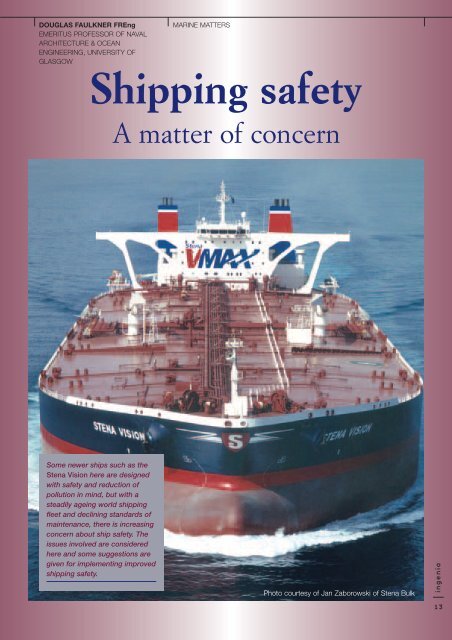
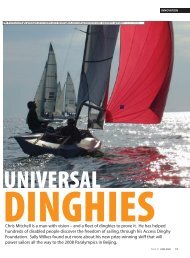


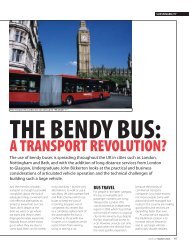
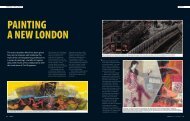
![[322/03] Francke - Ingenia](https://img.yumpu.com/23411337/1/184x260/322-03-francke-ingenia.jpg?quality=85)

